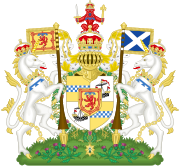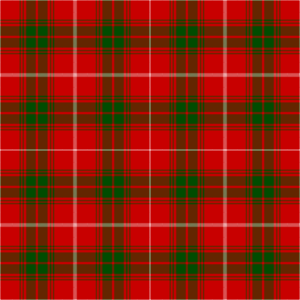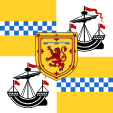Duke of Rothesay facts for kids
Quick facts for kids Dukedom of Rothesay |
|
|---|---|

|
|
| Creation date | c. 1398 |
| Creation | Third |
| Monarch | King Robert III |
| Peerage | Peerage of Scotland |
| First holder | David Stewart |
| Present holder | William, Prince of Wales |
| Status | Extant |
| Seat(s) | Adelaide Cottage |
The Duke of Rothesay is a special title for the person who is next in line to become the British King or Queen. This person is called the heir apparent. Right now, that's William, Prince of Wales. His wife, Catherine, Princess of Wales, is known as the Duchess of Rothesay.
This title was first used for the heir to the throne of Scotland. After 1707, when Scotland and England joined to form Great Britain, it became a title for the heir to the British throne. Today, it's used for the heir to the throne of the United Kingdom.
When the heir apparent is in Scotland, they use the title Duke of Rothesay. This is instead of their other titles like Duke of Cornwall or Prince of Wales, which are used in other parts of the UK. The Duke of Rothesay also holds other Scottish titles. These include Earl of Carrick, Baron of Renfrew, Lord of the Isles, and Prince and Great Steward of Scotland. The title is named after Rothesay on the Isle of Bute. However, it doesn't come with any land or property, unlike the Duchy of Cornwall.
Contents
What is the History of the Duke of Rothesay Title?
The title of Duke of Rothesay was first created around 1398. The very first person to hold it was David Stewart, Duke of Rothesay. He was the son of King Robert III. After David passed away, his brother, James, who later became King James I, received the title.
From then on, the oldest son of the Scottish King or Queen, who was next in line for the throne, would hold the Dukedom. A special law was passed by the Parliament of Scotland in 1469. This law made it official that the title would always go to the King's first-born son.
How Did Other Titles Join the Dukedom?
The title of Earl of Carrick has a long history, going back to the 1100s. In 1306, Robert the Bruce, who was the Earl of Carrick, became King Robert I of Scotland. At that point, the earldom became part of the Crown. Later, several heirs to the Scottish throne were also made Earl of Carrick. The 1469 law made sure that this title, too, would always belong to the eldest son of the Scottish monarch.
The role of Great Steward of Scotland started in the 1100s with Walter fitz Alan. The seventh Great Steward, Robert, became King Robert II in 1371. After that, only the heirs to the throne held this important position. The 1469 law also covered this title.
For a long time, between 1603 and the time of Edward VII, the title "Duke of Rothesay" wasn't used as much. People preferred "Prince of Wales." But Queen Victoria decided that the Duke of Rothesay title should be used for the heir when they were in Scotland. This tradition has continued ever since.
Who is the Lord of the Isles?

Another important title held by the heir apparent is Lord of the Isles. This title has a unique history. The Lords of the Isles were originally powerful leaders from the MacDonald family. They ruled the Western Isles and were like local governors under the Scottish or Norwegian kings.
In 1462, John MacDonald II, who was the fourth Lord of the Isles, made a secret agreement with King Edward IV of England. He hoped to become an independent ruler. However, in 1475, King James III found out about this. As a result, John MacDonald II lost his title. He did get it back later, but King James IV took it away again in 1493 after John's nephew caused a rebellion. Finally, in 1540, James V of Scotland gave the Lordship of the Isles to the heirs of the Crown.
What are the Rules for the Duke of Rothesay Title?
A law passed by the Parliament of Scotland in 1469 sets the rules for who gets most of these titles. It states that "the first-born Prince of the King of Scots for ever" should hold the dukedom. This means the title is only for the King's first-born son. If that son passes away before the King, his own children do not inherit the title. Also, the title does not go to the deceased duke's next brother, unless that brother also becomes the heir apparent.
Even though the law mentions "King," the eldest sons of Queens who ruled have also held the dukedom. However, the word Prince in the law does not include women.
Before 1963, the eldest son of the British ruler, as Duke of Rothesay, had the right to vote in elections for Scottish noble representatives. This right continued after the 1707 Acts of Union, which formally joined the kingdoms of Scotland and England to create Great Britain. However, the UK Parliament ended these elections in 1963.
Who Has Been Duke of Rothesay?
Here is a list of people who have held the title of Duke of Rothesay:
| Duke of Rothesay | Monarch | From | To | Other title held while Duke |
|---|---|---|---|---|
| David | Robert III | 1398 (created) | 1402 (death) | Earl of Atholl (1398), Baron Renfrew (?), Prince and Great Steward of Scotland (trad.) |
| James | Robert III | 1404 (created) | 1406 (acceded as James I) | Earl of Carrick (1404), Baron/Lord Renfrew, Prince and Great Steward of Scotland (1404) |
| Alexander | James I | 1430 (birth?) | 1430 (death) | Earl of Carrick (1430), Baron/Lord Renfrew, Prince and Great Steward of Scotland (1430) |
| James | James I | 1431 (created) | 1437 (acceded as James II) | Earl of Carrick (1431), Baron/Lord Renfrew, Prince and Great Steward of Scotland (1431) |
| James | James II | 1452 (birth?) | 1460 (acceded as James III) | Earl of Carrick (1452), Baron/Lord Renfrew, Prince and Great Steward of Scotland (1452) |
| James | James III | 1473 (birth) | 1488 (acceded as James IV) | Earl of Carrick and Baron/Lord Renfrew, Prince and Great Steward of Scotland (1469) |
| James | James IV | 1507 (birth) | 1508 (death) | Earl of Carrick and Baron/Lord Renfrew, Prince and Great Steward of Scotland (1469) |
| Arthur | James IV | 1509 (birth) | 1510 (death) | Duke of Albany (1509), Earl of Carrick and Baron/Lord Renfrew, Prince and Great Steward of Scotland (1469) |
| James | James IV | 1512 (birth) | 1513 (acceded as James V) | Earl of Carrick and Baron/Lord Renfrew, Prince and Great Steward of Scotland (1469) |
| James | James V | 1540 (birth) | 1541 (death) | Earl of Carrick and Baron/Lord Renfrew (1469), Lord of the Isles (1540), Prince and Great Steward of Scotland (1469) |
| James Charles | Mary | 1566 (birth) | 1567 (acceded as James VI) | Earl of Carrick and Baron/Lord Renfrew (1469), Lord of the Isles (1540), Prince and Great Steward of Scotland (1469) |
| Henry Frederick | James VI | 1594 (birth) | 1612 (death) | Prince of Wales and Earl of Chester (1610), Duke of Cornwall (1337), Earl of Carrick and Baron Renfrew (1469), Lord of the Isles (1540), Prince and Great Steward of Scotland (1469) (The italicised henceforth "Earl of Carrick, etc. 1469 & 1540)" |
| Charles, 1st Duke of Albany, 1st Duke of York | James VI | 1612 (death of brother Henry) | 1625 (acceded as Charles I) | Prince of Wales and Earl of Chester (1616), Duke of Cornwall (1337), Duke of Albany (1600), Duke of York (1605), Marquess of Ormond (1600), Earl of Carrick, etc. (1469 & 1540), Earl of Ross, Lord Ardmannoch (1600) |
| Charles James | Charles I | 1629 (birth) | 1629 (death) | Duke of Cornwall (1337), Earl of Carrick, etc. (1469 & 1540) |
| Charles | Charles I | 1630 (birth) | 1649 (acceded as Charles II) | Prince of Wales and Earl of Chester (1638), Duke of Cornwall (1337), Earl of Carrick, etc. (1469 & 1540) |
| James Francis Edward | James VII | 1688 (birth) | 1702 (attainted) | Prince of Wales and Earl of Chester (1688–1702), Duke of Cornwall (1337–1702), Earl of Carrick, etc. (1469 & 1540) |
| George, 1st Duke of Cambridge | George I | 1714 (father's accession) | 1727 (acceded as George II) | Prince of Wales and Earl of Chester (1714), Hereditary Prince of Hanover, Duke of Cornwall (1337), Duke of Cambridge, Marquess of Cambridge (1706), Earl of Carrick, etc. (1469 & 1540), Earl of Milford Haven, Viscount Northallerton, Baron Tewkesbury (1706) |
| Frederick, 1st Duke of Edinburgh | George II | 1727 (father's accession) | 1751 (death) | Prince of Wales and Earl of Chester (1729), Duke of Cornwall (1337), Duke of Edinburgh, Marquess of Ely (1726), Earl of Carrick, etc. (1469 & 1540), Earl of Eltham, Viscount Launceston, Baron Snowdon (1726) |
| George | George III | 1762 (birth) | 1820 (acceded as George IV) | Prince of Wales and Earl of Chester (1762), Duke of Cornwall (1337), Earl of Carrick, etc. (1469 & 1540) |
| Albert Edward | Victoria | 1841 (birth) | 1901 (acceded as Edward VII) | Prince of Wales and Earl of Chester (1841), Duke of Cornwall (1337), Earl of Carrick, etc. (1469 & 1540), Earl of Dublin (1850) |
| George, 1st Duke of York | Edward VII | 1901 (father's accession) | 1910 (acceded as George V) | Prince of Wales and Earl of Chester (1901), Duke of Cornwall (1337), Duke of York (1892), Earl of Carrick, etc. (1469 & 1540), Earl of Inverness, Baron Killarney (1892) |
| Edward | George V | 1910 (father's accession) | 1936 (acceded as Edward VIII) | Prince of Wales and Earl of Chester (1910), Duke of Cornwall (1337), Earl of Carrick, etc. (1469 & 1540) |
| Charles | Elizabeth II | 1952 (mother's accession) | 2022 (acceded as Charles III) | Prince of Wales and Earl of Chester (1958), Duke of Cornwall (1337), Duke of Edinburgh (1947), Earl of Carrick, etc. (1469 & 1540) |
| William | Charles III | 2022 (father's accession) | Incumbent | Prince of Wales and Earl of Chester (2022), Duke of Cornwall (1337), Duke of Cambridge (2011), Earl of Carrick, etc. (1469 & 1540) |
Who is the Current Duke of Rothesay?
Since 2022, William, Prince of Wales, has held the title of Duke of Rothesay. He uses this title when he is in Scotland. His formal Scottish title is HRH The Prince William, Duke of Rothesay.
The personal shield of the previous Duke, King Charles III, was given to him by the Queen in 1974. This shield shows symbols of the Great Steward of Scotland and the Lord of the Isles. The current Duke's shield is a bit different. It includes a small shield in the middle showing the Royal arms of Scotland with a three-point label. This label shows that he is the heir apparent to the King of Scots. The full design of the current Duke's arms is a special version of the Royal coat of arms of Scotland that was used before 1603.
Images for kids




